I made a pilgrimage unawares and it left me in an agitated silence among the incense smells of Indian tourists curiouser than even this foreigner. On the first day in New Delhi, I was taken to the palatial Birla House on Albuquerque Road to touch the place where the great man of peace, Mahatma Ghandi, was assassinated. I was overwhelmed by the simplicity of this man who stirred up his people in the face of the colonialists to open the doors to independence. I had lea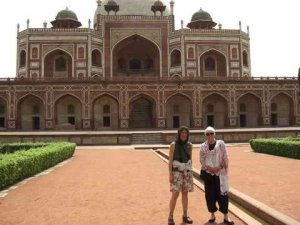 rned about him in my youth like many Americans through the Ben Kingsley interpretation in the movie Ghandi. Now I was here where he had been. It was a parallel emotion one has standing before that disruptive balcony at the Lorraine Motel to remember another great man lost too soon, too cruelly, to ridiculous bullets in another inexplicable act. Two pacifists both of whom sensed that their ends were imminent, their work done, although it was really t
rned about him in my youth like many Americans through the Ben Kingsley interpretation in the movie Ghandi. Now I was here where he had been. It was a parallel emotion one has standing before that disruptive balcony at the Lorraine Motel to remember another great man lost too soon, too cruelly, to ridiculous bullets in another inexplicable act. Two pacifists both of whom sensed that their ends were imminent, their work done, although it was really t he beginning of their struggles for freedom.
he beginning of their struggles for freedom.
We pulled away from the luxuries of the Oberoi Hotel with its choice of bed pillow fillings into 104 degree heat of a morning to parade through the many giant dome shaped pink mausoleums – mini Taj Mahals – maharanis built to honor their maharajas and also to be their final resting places with large cells for everybody in the family. We struck up deep steps of Humayun’s tomb to see undecorated tomb rooms and walk through water flow strips and stand beside the holy Peepah tree. It was enough to work up a sweat. Throw the shawl over your exposed arms. The Peepah tree, according to our guide, is where Vishnu, Shiva and Brahman hang out, a trinity of generator, or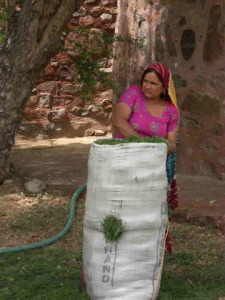 ganizer and destroyer from which the rest of the Hindu gods were reincarnated.
ganizer and destroyer from which the rest of the Hindu gods were reincarnated.
This reincarnation idea is quite a handful. They look at the end as not being the end because you can come back in a better way – or a worse hell, depending on how you behaved in your most recent appearance on this planet. On the negative side, you’d come back an animal. On the positive, you might come back as an auxiliary god, or at least that’s what it seems to me. Everyone wants to be remembered by their Karma, the good deeds one manages to d o in his time span of life. Hindus feel if you are born into poverty, it’s because of previous bad deeds or such deeds in a previous life. But regardless, just keep on working, give your best to the world, (I guess that means to accept your fate) and don’t think of the consequences because it won’t taint your love, rather it’ll come back to you good, like giving to the poor. Hindus are active coin droppers in the hands of beggars and lesser casts. Kids sell whatever between cars, banging on windows, trying to get your attention, and you don’t want to look because one might hold up an arm without a hand. But as I try to ignore, I cannot because I know Ghandi would have reached out his hand without a rubber glove to protect him from disease to give hope.
o in his time span of life. Hindus feel if you are born into poverty, it’s because of previous bad deeds or such deeds in a previous life. But regardless, just keep on working, give your best to the world, (I guess that means to accept your fate) and don’t think of the consequences because it won’t taint your love, rather it’ll come back to you good, like giving to the poor. Hindus are active coin droppers in the hands of beggars and lesser casts. Kids sell whatever between cars, banging on windows, trying to get your attention, and you don’t want to look because one might hold up an arm without a hand. But as I try to ignore, I cannot because I know Ghandi would have reached out his hand without a rubber glove to protect him from disease to give hope.
Ghandi was shot by a Hindu fanatic January 30, 1948. At Birla House, where he lived the last 144 days of his life in not wonderful health, a tourist or a pilgrim walks through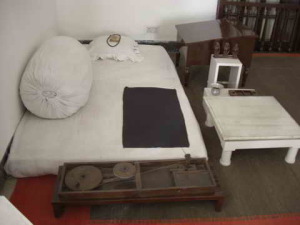 the simple white and brown room where he once found peace and sleep. His wooden spinning machine sits at the end of the floor mattress where he slept, a giant barrel pillow still rests against the wall. A rectangle of brown weaving rests on the edge. Then on a table are his prayer beads, and the statues of three monkeys Hear No Evil, See No Evil, Speak No Evil. How odd. His walking stick and frail spectacles, his “chappals” or sandals, really his few possessions, are left as they were on the day of his death. His library of books was in another corner, but you can’t really stay there and absorb the grief, because Ghandi, like Martin Luther King Jr., was a man of his time and yet before his time. Throughout this small museum are giant placards on which photogra
the simple white and brown room where he once found peace and sleep. His wooden spinning machine sits at the end of the floor mattress where he slept, a giant barrel pillow still rests against the wall. A rectangle of brown weaving rests on the edge. Then on a table are his prayer beads, and the statues of three monkeys Hear No Evil, See No Evil, Speak No Evil. How odd. His walking stick and frail spectacles, his “chappals” or sandals, really his few possessions, are left as they were on the day of his death. His library of books was in another corner, but you can’t really stay there and absorb the grief, because Ghandi, like Martin Luther King Jr., was a man of his time and yet before his time. Throughout this small museum are giant placards on which photogra phs and descriptions of the last 24 hours of his life are detailed. It’s hard to stand and read them. They turn the intestine because you know what is coming. In another room are dolls in large glass boxes depicting the major moments in Ghandi’s life, including his meeting with British King at Buckingham Palace on English shores.
phs and descriptions of the last 24 hours of his life are detailed. It’s hard to stand and read them. They turn the intestine because you know what is coming. In another room are dolls in large glass boxes depicting the major moments in Ghandi’s life, including his meeting with British King at Buckingham Palace on English shores.
Ghandi gave no excuses, knowing he had maybe gone as far as he could go, he had stood on the mountain top like Rev. King had done, and knew it was to be vacated abruptly. Ghandi said: “My life has been an open book. I have no secrets and I encourage no secrets.” On this last day, his two young nieces accompanied him, helping his rather fragile movements, as he met his meetings for that day, prayed with those needing prayer, and wrapped the white cloth around him as the afternoon breeze began to wear down the sun. “My goal is friendship with the world. I can combine the greatest opposition to wrong.” As the day’s heat waned, he walked with the two young girls to an area where he would hold an afternoon prayer meeting – there are concrete footprints of his exact steps, and a marker where he saw the assassin raise the gun from his own underarm to shoot him. Ghandi’s last words were, “Hey Ram!” or “Oh God.”
We tried to pick ourselves up with a stop at the Crafts Museum, an oasis of thatched huts and bu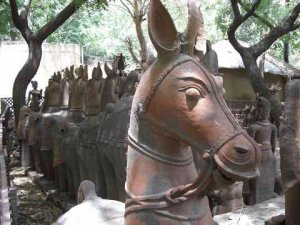 ildings to sample native crafts, but the heat is so invasive, there were few craftsmen peddling wares. I was fascinated by paintings on palm leaves with secret Kama Sutra flaps to lift up, extraordinary textiles to stir the most reluctant fiber artist and there was fine metalwork Calder style, and intricate Mogul woodwork in a jharokha – two story balcony like I had seen i
ildings to sample native crafts, but the heat is so invasive, there were few craftsmen peddling wares. I was fascinated by paintings on palm leaves with secret Kama Sutra flaps to lift up, extraordinary textiles to stir the most reluctant fiber artist and there was fine metalwork Calder style, and intricate Mogul woodwork in a jharokha – two story balcony like I had seen i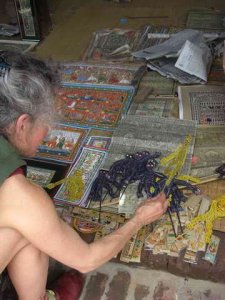 n Kathmandu. I couldn’t figure out, though, a giant black wooden structure on wheels – maybe three stories tall – looking like a suspect Trojan horse. I couldn’t find data in English. This museum had endless entertainment as you strolled from house to room to upstairs to patio and even then I missed a lot of it.
n Kathmandu. I couldn’t figure out, though, a giant black wooden structure on wheels – maybe three stories tall – looking like a suspect Trojan horse. I couldn’t find data in English. This museum had endless entertainment as you strolled from house to room to upstairs to patio and even then I missed a lot of it.
Photos: Sue and I wonder who’ll make one of these for us; A Hindu woman of the mausoleum; the grass collector; Standing by the Peepah tree; Ghandi’s last day things; the obelisk marking Ghandi’s assassination; metal horses huddle at the crafts museum; Sue testing wooden tigers.
